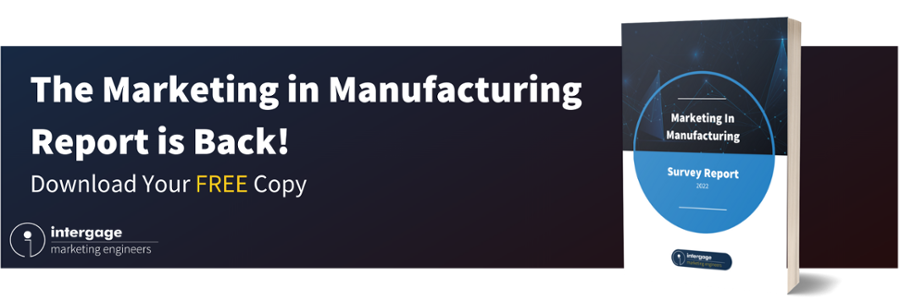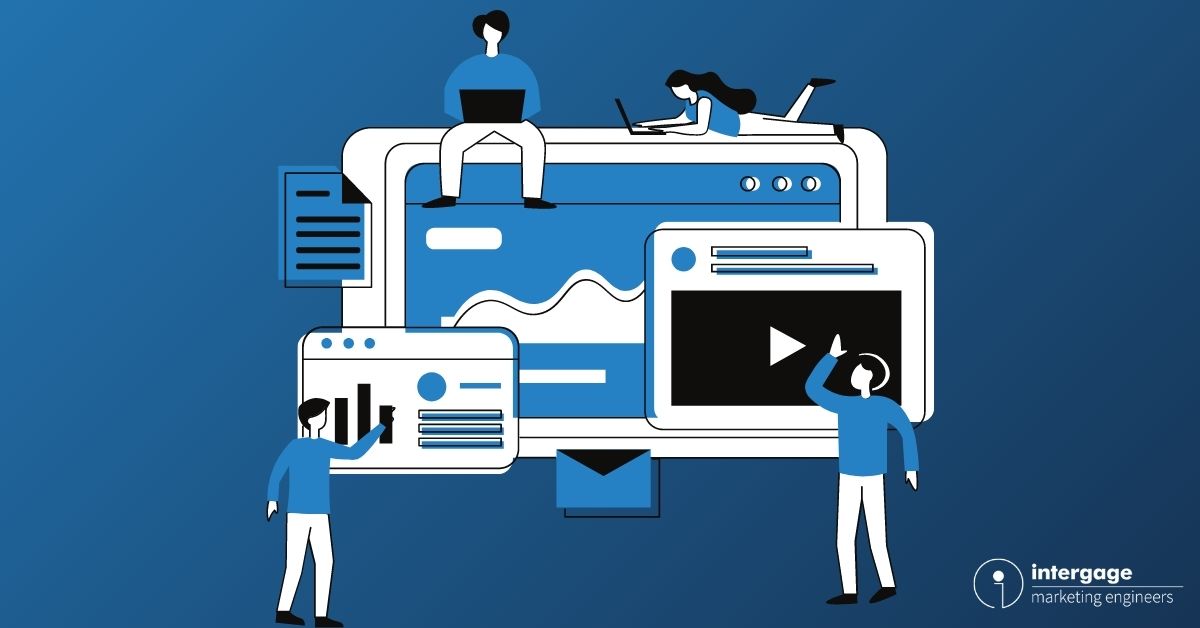7 Steps To Perfect Inbound Marketing For Manufacturers
Inbound marketing is the process of creating tailored content for a specific target market with the aim of attracting prospects on their terms. This means creating helpful, contextual content that answers their questions and solves their problems until the point at which they are ready to buy/be contacted by sales.
Compared to more traditional, outbound marketing, inbound marketing causes much less interruption for prospects and only shows them content they want to see, when they want to see it. We talk more about the differences between inbound and outbound marketing here.
Why Does Inbound Marketing Matter For Industrial Businesses?
Buyer behaviour has changed. Today’s buyers hold all the cards – B2B buyers, in particular, use the internet as their number one source of information when researching potential solutions. Statistics vary but it’s estimated that a B2B buyer will be at least 60% of the way through their buying journey before engaging with a salesperson.
With the average engineering and manufacturing business offering more complex solutions than most, this research process is crucial. And if you aren't showing up in search engines and your competitors are, you're losing out on sales opportunities!
Therefore it’s really important to align your content with your prospect’s buying cycle so you can serve relevant, useful information to build trust and help your buyer through their journey. Think of it as a sales and marketing production line...
If you want to create a successful inbound campaign for your engineering or manufacturing business, there are 7 key steps you’ll need to consider.
The 7 Steps to Execute the Perfect Inbound Campaign
1. Identify Your Target Audience
Each campaign should commit to a certain message for a specific audience. You can’t be all things to all people. It’s important to consider the following when developing a campaign in order to make sure every engagement is highly targeted for your audience:
- Pick a specific sector – without focusing on a sector you’ll find it difficult to fully align your content with the typical business objectives of your target clients. Buying cycles, customer value and competition are all completely different depending on the industry a business is in!
- Pick a specific persona – similarly, without understanding the pain points, buying triggers and objectives of each individual persona, your content will come across as a bit ‘vanilla’.
- Agree which parts of the buying journey your content will influence – for example blogs defining and introducing a subject are considered ‘top of funnel’ content whereas a product demo is suitable for users much further down the journey.
Once you have agreed who you will target, you’ll be able to define the objectives and KPIs for the campaign. One outcome you may wish to track could be the number of white paper downloads and how many of these converted into sales-qualified leads.
2. Develop Campaign Messaging And A Content Offer
A content offer is a key piece of content in any inbound campaign. Content offers are designed to attract and interest users to part with their contact details in return for the content offer. Typical content offers in the industrial sector might include:
- a white paper
- a product demonstration
- a guide or eBook
- a webinar.
Our own Marketing In Manufacturing Report is an example of a content offer in itself!
For a successful campaign, you’ll need to decide on a content offer that is:
- valuable
- challenging
- educational and informative
- aimed at your chosen sector
- aimed at your chosen persona.
Your offer needs to be valuable enough to attract new visitors and interesting enough to encourage visitors to read more. There is no one-size-fits-all here!
3. Surrounding Content
Creating content (and lots of it) is a key part of any inbound campaign. Blog content is still pivotal in supporting campaign activity and in our experience, you need a minimum of 10 - 20 supporting blogs and articles to build traction and support organic search. This will ensure that your site is found for relevant searches and questions.
This clearly works in the industrial sector too, with 43% of industrial companies rating regular written content in the top three most successful marketing activities for 2020. Moreover, 80% of manufacturers and engineers state they will be investing in content marketing over the next 12 months (The Marketing In Manufacturing Report).
Here are some top tips to take into consideration when creating blog content:
- Talk in a language that will resonate with your audience
- Use the keywords and terms they use to describe your services
- Share your content on social media and get your team to help build reach
- Answer common questions asked by your key personas
- Include a call-to-action on EVERY blog that points to your content offer
- Leave your audience needing more!
Of course, building up this body of content takes time. So, in the interim you may decide to supplement content creation with some paid advertising, or outsource content creation to a marketing agency.
4. Promoting Content Through Advertising
Paid search can be a great way to support any inbound campaign, allowing you to drive a steady stream of leads to your content while getting insights into what your audience is searching for.
Start by doing some keyword research to identify and target long-tail phrases that link to your content offer and campaign. Make sure you drive traffic to relevant landing pages or a ‘pillar page’ (we'll talk more about those later) and – as you would with any paid search campaign – split test ads and landing page content to improve conversion rates.
Depending on the offer, we would typically recommend that you focus on the search network in Google Ads (target keyword searches) and incorporate re-marketing to build brand awareness and remain front of mind. However, other platforms such as LinkedIn, Facebook and even Bing Ads can be great supporting channels too!
5. Create Content Pillars
What is a content pillar?
Content pillars are made up of several blogs and supporting pieces of content (cluster content) that feed into a main pillar page. The pillar page summarises each of the blog posts surrounding it and links back into each of the blogs. Take a look at our own pillar page for marketing in manufacturing here!
The below shows a close representation of what this looks like:

The pillar page forms the hub of the campaign and will promote the content offer – this page is designed to consolidate all relevant information into the one page and should provide further insights aimed to help the searcher.
Don’t worry if the page is long and scrolls way below the fold! The more information and content on the page the better!
6. Capture Data And Nurture Leads
The data captured from your content offer should go into your CRM. Once in the database, a series of emails should be used (using marketing automation) as part of a sequence to nurture the lead into taking the desired action.
Once the lead has completed the action (or set of actions) required to be considered a sales opportunity, they should be handed to your sales team to follow up.
That means your salespeople only deal with leads that are ready to buy, and your content does the rest of the work for them!
This part of the process does require you to have access to marketing automation software. Traditionally, engineers and manufacturers have been slow on the uptake of marketing automation so those that are using it well have a huge competitive advantage!
7. Measuring Success
You wouldn't invest in a piece of equipment for your production line and then not measure its performance. Your inbound marketing production line is no different.
It’s important to measure your campaign performance against goals and KPIs set at the beginning of the process. Reporting back on results on a monthly basis will allow you to learn lessons and make informed decisions to enhance the user experience.
It'll also allow you to understand where your campaign isn't working so well and where efficiencies can be made to improve results - just like on your real production line.
Again, there is no one-size-fits-all solution here, although new sales leads generated, website conversions and leads to sales conversion rates were all listed at the most popular marketing KPIs for engineering and manufacturing business in The Marketing In Manufacturing Report.
The Benefits Of Adopting Inbound
Inbound marketing empowers buyers with timely, helpful content, rather than interrupting them with unwanted irrelevant communications.
It allows you to target specific, best-fit buyer personas – in turn creating higher quality leads for your sales team. It provides prospects and leads with a more relevant experience while supporting the digital purchasing journey that modern buyers go through.
Another really important point to consider is that by HELPING rather than SELLING to prospects, inbound establishes manufacturing and engineering businesses as trusted sources of information – rather than as pushy sales-obsessed individuals.
Remember, the inbound methodology is designed to:
- attract relevant visitors to your website
- convert visitors into leads
- nurture and close those leads into customers
- continue to engage and delight those customers
- transform them into promoters!






